Most readers of this blog undoubtedly find birdsong soothing.
What’s not soothing is unexpectedly hearing an American Bittern. Even when you’re sipping hot tea next to calm, freshwater wetlands at Sleeping Giant Provincial Park in Ontario, Canada on the north shore of Lake Superior.
The Cornell Lab of Ornithology calls the bittern’s song the “gulps of a thirsty giant.” Take it from me, it’s positively jarring. And that’s just one of the surprises of the bizarre bittern.
Strange Sounds
“[The American Bittern song] has been described as the sound of someone taking an old crank pump and getting water out,” says Dr. Frederic Reid, the director of conservation programs at Ducks Unlimited, describing the American Bittern call as sounding like the three words “pump-er-lunk.”
“You’re in the middle of this marsh, you hear this noise, and it sounds mechanical,” adds Reid. “It’s so bizarre to hear this noise.”
Hearing this sound in the wilderness led me on a year-long path of investigation into, and appreciation of, this peculiar, solitary bird.
Stephanie Beilke, conservation and science associate at Audubon Great Lakes, said this call is used for both courtship and territory defense.
“One American Bittern will be sitting one spot, usually around dusk or dawn, and it will make this sound. It will let other bitterns nearby know ‘this is where I am, this is my territory,’” she says. The pump-er-lunk call often takes place in multiple bursts, and the bursts are repeated throughout a whole dusk or dawn period.
“When you hear it in the marsh, you are shocked because it seems so out of character for a bird, or insect, or frog call,” said Reid.
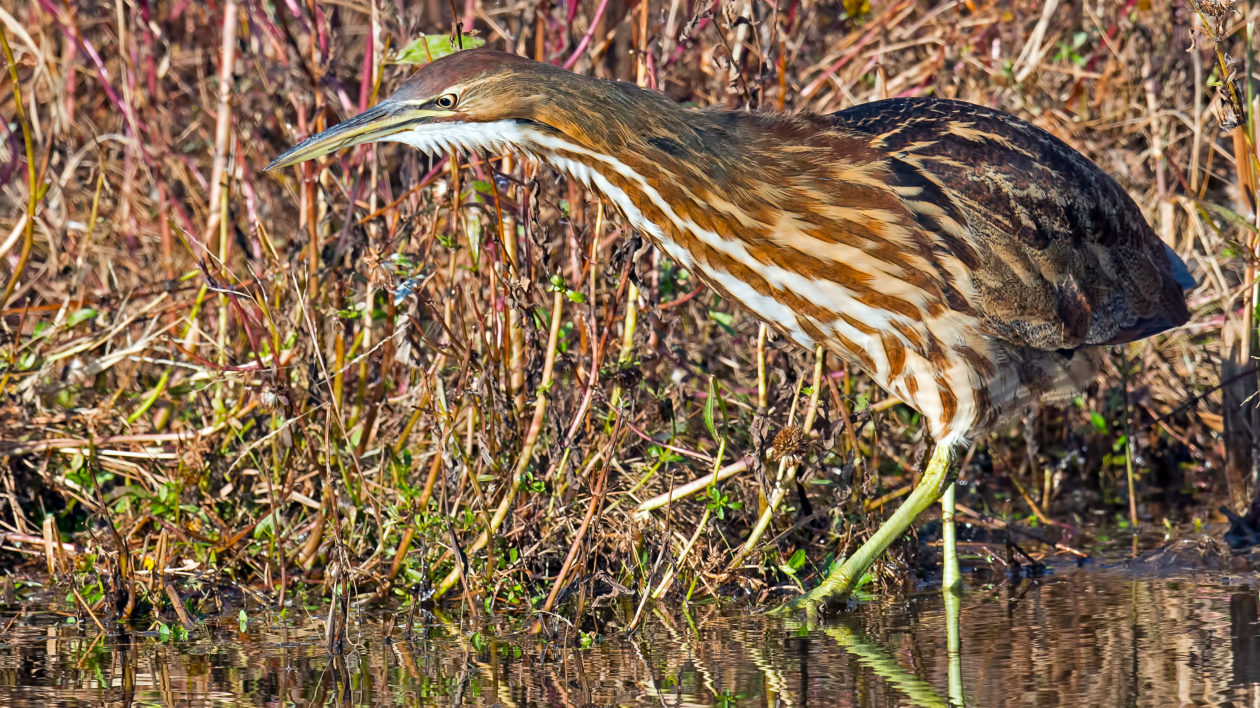
Clever Camouflage
Their strange sounds can catch you off-guard when you’re outside near wetlands. Over the course of a four-day camping trip, my husband George and I never managed to spot these secluded birds. Based on the volume of the song we heard, there was one that hung out close by, but we simply couldn’t find it. And trust me, we tried.
According to Beilke, the inability for birders to track down the American Bittern is common. “You could hear that sound but never see one,” she said. Audubon Great Lakes classifies this bird as a secretive marsh bird. It’s hard for birders and scientists to spot one because bitterns have impressive camouflage.
The American Bittern is a brown and buff heron, about 23-inches-long, with a 45-inch wingspan. They have dark, vertical stripes on their necks that make them camouflaged among the freshwater grasses – a necessary adaptation. As these birds are often found on the edges of shorelines, without tree cover, camouflage is essential to avoid predators and avoid being seen by prey. As a further adaptation, the bird has become an expert at the stealthy stake-out, learning how to disappear among the reeds.
To avoid detection, one will freeze, often for long periods of time, with its long, narrow neck and bill stretched skyward, while its eyes are cast downward.
This posture helps it hide among the tall vegetation fringes and shorelines. The American Bittern may sway its neck slowly prior to capturing prey, resembling the sway of tall grasses. The Cornell Lab of Ornithology said this movement is mainly done so the bittern can overcome glares on the water.
It also allows a bittern to have a quicker strike, because its muscles are already in motion when the strike begins. When the time is right, the camouflaged bittern captures passing prey, including insects, amphibians, crayfish, small fish and mammals.
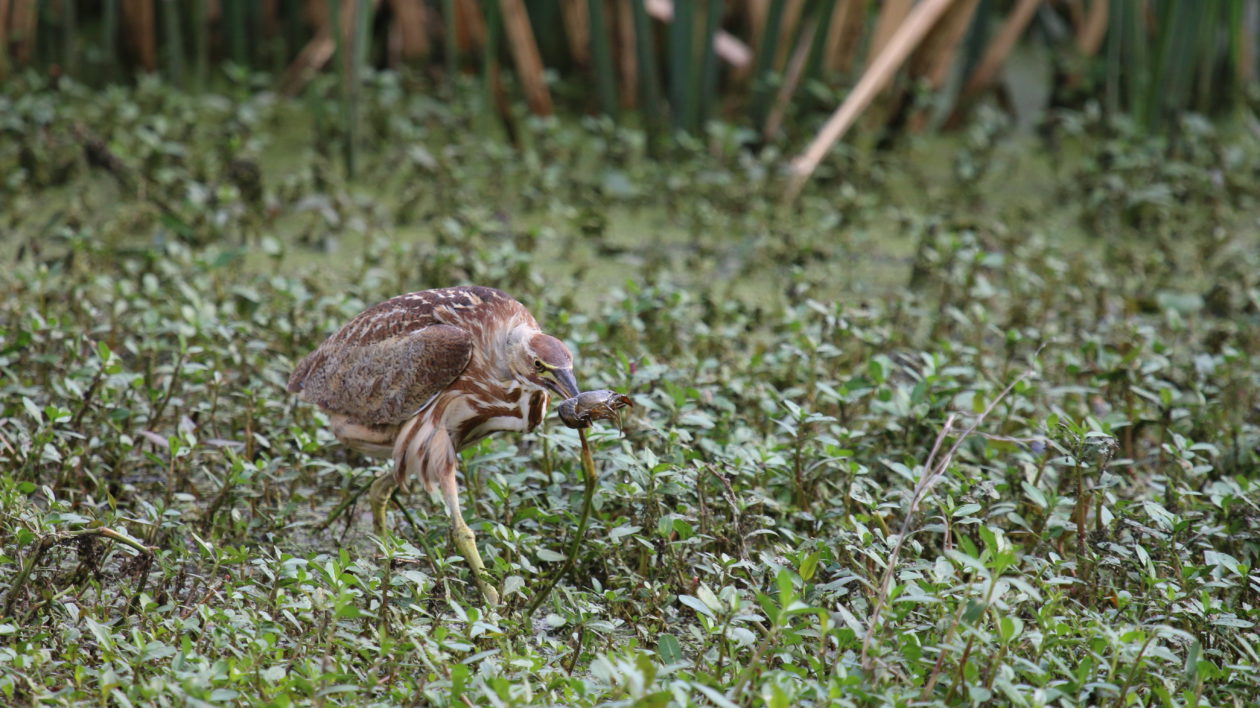
Bizarre Behaviors
Due to its natural coloring, you could say the bittern isn’t the most stunning bird out there. But consider its intriguing behaviors.
It’s fascinating to watch the American Bittern physically perform its song. “It almost looks like the bittern is swallowing a bunch of air that’s coming from within the bottom of its throat,” said Beilke. “The bird leans into it and stretches its throat out in this big convulsing motion.”
This bird’s bizarre behaviors extend to its flight patterns, as well. When lifting off, Cornell’s profile says it appears “hurried, ungraceful and stiff.” And when territorial males engage in defensive displays, they approach each other in low, defensive crouches before an aerial chase ensues. In combat, they will fly in tight, ascending spirals and try to stab one another.
Another aspect of bittern behavior is that it often shows up in strange places during migration, becoming confused by lights and windows. “Since most people don’t regularly encounter bitterns in their yard, when one appears there it tends to really stand out,” said Beilke. “Injured or out-of-place bitterns usually adopt a defensive posture which almost makes them look like a Jim Henson creation rather than a bird.”
If you see a bittern in an unexpected place during spring or fall migration, and it appears unable to fly, Beilke recommends that you contact your nearest wildlife rehabilitation center.
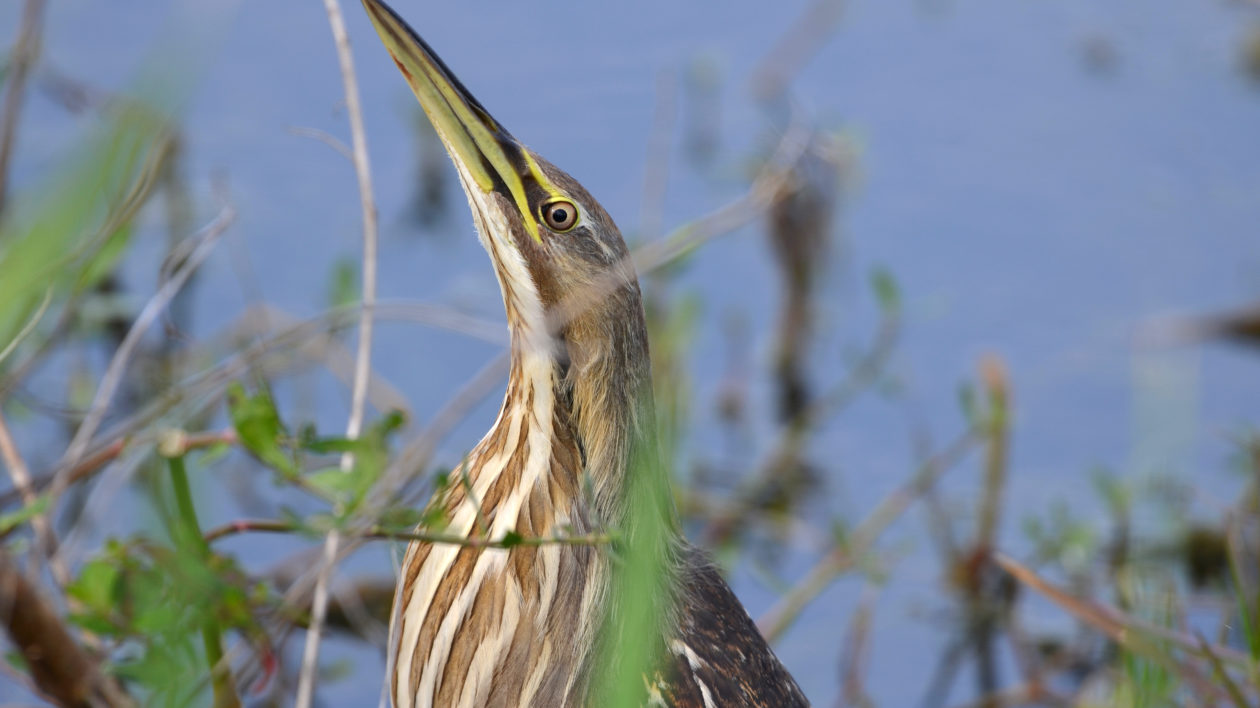
Conservation Concerns
Throughout the United States, there’s a loss of good quality wetlands, which Beilke attributes partially to invasive species such as carp. “We’re seeing a loss of complexity in these ecosystems, and the less complex, the fewer species thrive in it,” she says, also noting that pollution and fragmented wetlands, due to development, are also to blame.
“The American Bittern is a wonderful indicator to measure large, quality wetlands because these species are very picky about what kind of habitat they can use,” said Beilke.
The species is substantially declining in this country, and Cornell states that research on its natural history would help conserve this curious species. “Because of this species’ secretive nature and inaccessible habitats, remarkably little is known about the basic aspects of its biology, including sources of mortality, habitat use, mating systems, and population structure,” Cornell writes in its Birds of North America database.
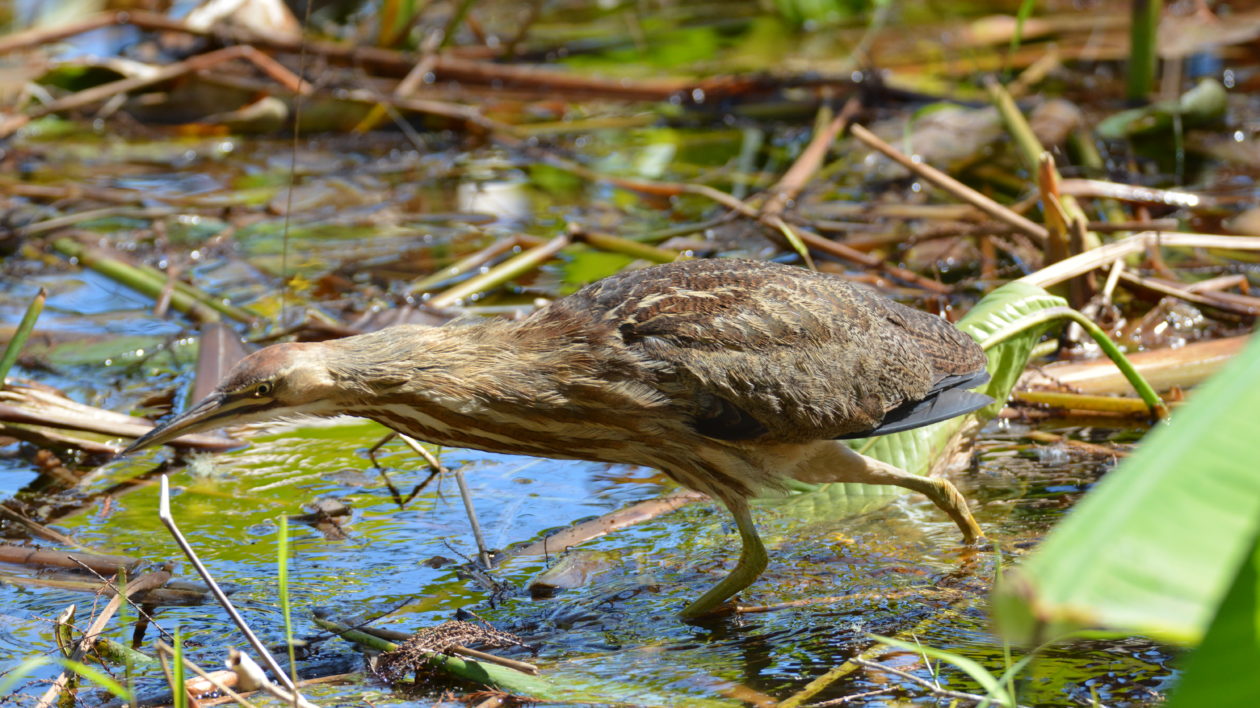
For Further Exploration: Those interested in learning more about the American Bittern, or witnessing it in action, can explore The Cornell Lab of Ornithology and Audubon.
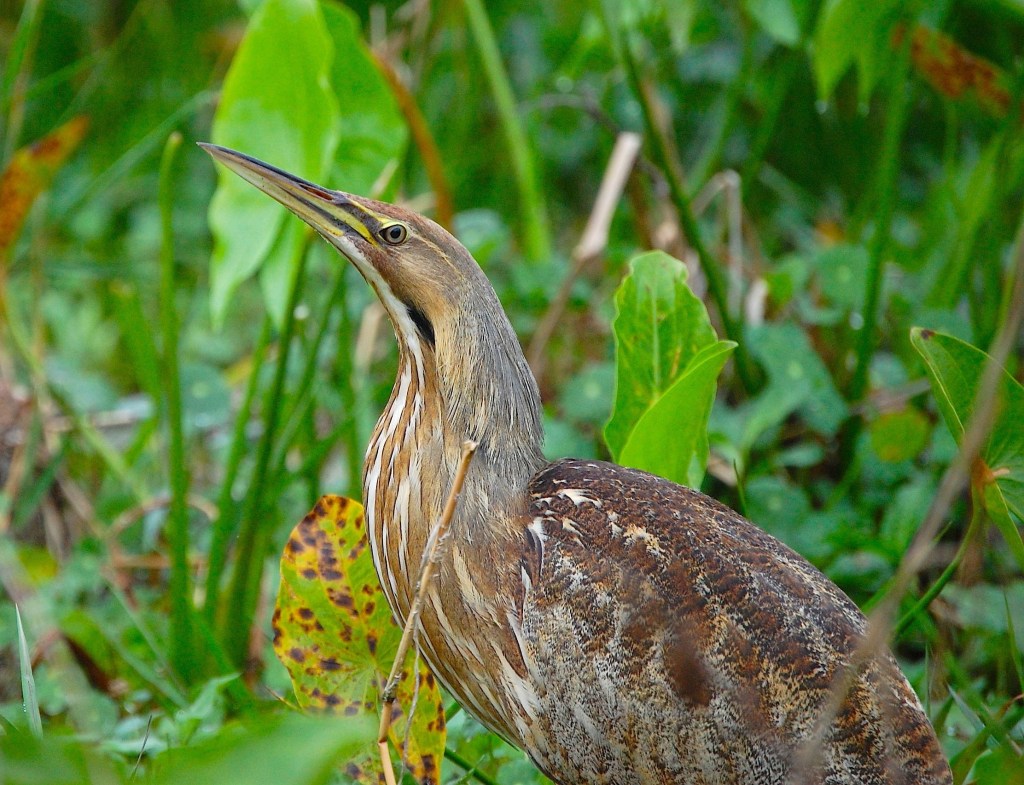



Spotted one flying low over a marshy shore in west central Florida yesterday and thought, what was THAT? I’m a native Floridian and had never seen one that I know of.
it love to eat baby bluegills
We live at Manitowaning Ont.
We have a small creek that goes in the middle of the property we live in the country.
And we have the American Bittern and the Least Bittern they are the strangest bird to watch.
Also the sound they make is so weird but nice.
The Least Bittern are new this year last year we had the American Bittern.
But we got both birds this year. They love the creek.
Hi! Iive in Bedford, Texas and happened to glance out on my stone patio and a lovely bittern was proudly standing there, melting into the fence & tan stone. I had never seen one, and looked him/her up. He provided company for a few short hours. I think he may have eaten a few small lizards or bugs in the garden.
What is the literary allusion “……with bittern eyes” from and does it refer to the watcher’s eyes or the bittern’s?
My daughter filmed a American bittern on her back fence she said there is two and they are in her plines she lives in horseheads NY
I encountered one in North Central Florida at a boat launch ramp. It did not appear in the least bit shy for that matter it appeared to pose for me.
I’m still amazed at the wonderful photographic and “voiced” videos like this one on the American Bittern.
Imagining going where those who capture such nature adventures go, while in my easy chair, enhances my world and gives me access to the nature I love, all amidst this oldster’s physical limitations. Thanks
to the many who make this possible.
Great Article!
The only time that I saw an American bittern in the wild happened in a Chicago forest preserve when I stepped on a thorn and let out a loud yowl. A previously undetected bittern squawked and took off very close to me. I didn’t think so at the time; but, retrospectively, I have to say “Thanks” to that thorn.
I read the entire article yet I still don’t know where in the U.S. these birds are found.
I live in Central Wisconsin and when I was a kid we used to get bitterns in our 3 acre yard every Spring. Haven’t seen one in at least 30 years.
I live in Westfield Vermont at about 1300′ elevation in the very north of the green mountains a few miles south of the Canada border. Last year as I was leaving home (I have a wetland area & pond) with no close houses on my small rural dirt road, I was surprised at the last second to see a rust colored bird that looked like a bittern I later looked up. It impressed me in the way it flew straight up in the air from standing in the water. I’ve never seen a bird that could fly straight up like that.
Great photos. I feel like I am right there with this Bittern. I would have never guessed that sound was made by a bird.
Thank you,
Years ago a young bittern stepped onto the bow of our canoe as my wife and I were slowly working our way down a very narrow brook through a bog. It only took the bittern a few seconds to decide to jump ship. My wife had already decided she wanted no part of that sharp bill so close to her face.